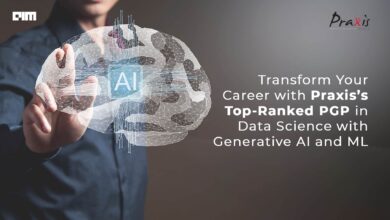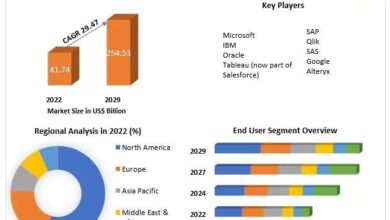Business Intelligence: Next-Generation Data Analytics

Making informed decisions based on data-driven insights has become paramount in the ever-evolving business landscape. As we stand on the cusp of a new era, characterised by rapid technological advancement and unprecedented access to data, the next generation of business intelligence (BI) will revolutionise how businesses operate, innovate, and thrive in the digital age.
Traditionally, BI has been synonymous with static reports and dashboards, providing businesses with historical insights into past performance. While these tools have proven valuable in their own right, they must catch up in today’s fast-paced, data-driven world, where real-time decision-making is the key to staying ahead of the curve.
Enter the next generation of BI, which goes beyond mere reporting to deliver dynamic, actionable insights in real time. Powered by advanced analytics, machine learning, and artificial intelligence (AI), this new breed of BI empowers businesses to anticipate trends, identify opportunities, and mitigate risks with unprecedented speed and accuracy.
At the heart of next-generation BI lies advanced analytics, a suite of techniques and technologies that enable businesses to extract meaningful insights from complex and diverse datasets. From predictive modelling to prescriptive analytics, these tools allow organisations to move beyond descriptive analysis and into predictive and prescriptive decision-making.
Speaking to Silicon UK, Leo Carbonara, VP of Product, BlueConic, explained how data delivers new experiences to customers: “There’s a growing demand for ‘invisible experiences,’ where data is leveraged to personalise consumer interactions in a subtle and seamless manner. This approach enhances customer engagement by delivering tailored experiences at pivotal moments in their journey, without feeling intrusive.”
Take predictive analytics, for example, which harnesses historical data and statistical algorithms to forecast future outcomes. By identifying patterns and trends in past behaviour, businesses can anticipate customer preferences, demand fluctuations, and market dynamics, enabling them to proactively adjust their strategies and stay ahead of the competition.
Harnessing the Power of Machine Learning and AI
Machine learning and AI are making a significant impact in natural language processing (NLP) and natural language generation (NLG). By enabling computers to understand and generate human language, these technologies facilitate more accessible and intuitive interaction with data, allowing users to ask questions, receive answers, and gain insights in plain English.
Also, machine learning algorithms can adapt and learn from new data over time, continuously refining their models and improving the accuracy of their predictions. This iterative approach to analytics ensures that businesses remain agile and responsive to evolving market conditions and customer preferences.
As the complexity and volume of data continue to grow, the demand for self-service BI solutions is rising. These platforms empower business users with the tools and capabilities to explore data, create visualisations, and generate insights without relying on IT or data science teams.
“VodafoneZiggo uses our platform to achieve a variety of use cases, including churn reduction,” explained BlueConic’s Leo Carbonara. “By connecting churn probability scores to their BlueConic profiles, the company is able to automatically route at-risk customers to chat with customer support specialists online. Using this method, they saw a 4.53% reduction in churn in relation to the control group, a 7.14% increase in chats, and decreased web-to-call by 7.14%. By reaching the right customers and resolving their issues, customer satisfaction increased which led to saved revenue.”
Self-service BI accelerates decision-making and fosters a culture of data-driven innovation and collaboration within organisations. By democratising access to data and insights, these platforms enable employees at all levels to make informed decisions, drive performance improvements, and unlock new growth opportunities.
Despite the tremendous potential of next-generation BI, businesses must address challenges to fully harness its benefits. Chief among these is the issue of data quality and governance, as inaccurate or incomplete data can lead to flawed insights and misguided decisions.
Adam Mayer, Technical Product Marketing Director, at Qlik, explained to Silicon UK how businesses can harness these tools: “Insights from data are only as good as the actions taken from it,” he says. “Connecting generative AI with operational systems can cause an automated trigger action for teams, and businesses can ultimately benefit from this transformative technology. Integrating AI-powered analytics to examine data in real time gives immediate insights and recommendations on predefined triggers or thresholds. These triggers can then be set to specific actions or alerts when conditions are met. This is effectively a no-code automation solution which can create advanced workflows. By connecting this to all business applications, there is the potential for organisations to trigger action from their systems.”
Additionally, as businesses become increasingly reliant on AI and machine learning algorithms, there are concerns around bias, transparency, and ethics that must be carefully navigated. Ensuring fairness and accountability in algorithmic decision-making is essential to building trust and maintaining credibility with customers, regulators, and other stakeholders.
However, with these challenges come opportunities for innovation and differentiation. By investing in robust data governance frameworks, leveraging emerging technologies responsibly, and fostering a culture of data literacy and ethics, businesses can position themselves for success in the era of next-generation BI.
“As the hype around generative AI dies down, we expect to see a broader uptake of different, more industrial AI tools over the coming months,” commented Rob McGreevy, Chief Product Officer at AVEVA. “Industries are onboarding many different AI technologies, including advanced analytics and predictive asset optimisation.
“Advanced analytics programmes can effortlessly construct and run no-code AI-driven models, simplifying how industrial workers optimise production efficiency. For example, consider that even minor process variations can greatly impact production outcomes. By crunching hundreds of variations with detailed recommendations, AI models enable operators to make confident decisions.”
Challenges and Opportunities
“Advanced analytics, as deployed by Google, meta, Amazon, Netflix etc., make it easier to join up user behaviour across platforms – a kind of digital surveillance that has eroded digital privacy without users being aware what they are giving away in return for a ‘free’ service,” says Sara Boltman, founder, Butterfly. “GDPR and other legislation is attempting to restore some of this balance, but many users see the popups as a minor irritation and simply click through without reading or thinking about it. Rather than being ‘extractive’ and keeping everything just in case it one day turns out to be monetisable, businesses should consider what they really need. This will reduce their storage costs over the long term and in the event of a data breach there will be less damage.”
By embracing these innovations, organisations can gain a competitive edge, drive innovation, and unlock new opportunities for growth and success in the digital age. However, to realise the full potential of next-generation BI, businesses must invest in the right technologies and cultivate a culture of data-driven decision-making and ethical data use. In doing so, they can navigate the complexities of the modern business landscape with confidence and agility, paving the way for a future where data is not just a tool but a strategic asset driving business success.
BlueConic’s Leo Carbonara closed by stating: “Next generation data analytics solutions will introduce new strategies and tactics that require companies to re-examine the structure, resources, and workflows that will enable them to achieve the desired outcomes. In other words, the tried-and-true “people, process, technology” framework remains essential for driving permanent and scalable change. When change is managed correctly, companies can realise the full potential of their investment not only in the performance outcomes it delivers, but also in the operational efficiencies it drives for the business as a whole.”
Dr Clare Walsh, Director of Education at The Institute of Analytics, concluding: “I think in 2024, no CEO should be making decisions from just a ‘bar chart on page 4’ of a report unless the conclusion is simple and obvious. In modern business, decisions are more complex. Senior leaders should work with interactive visualisation dashboards instead. These have a series of dials where decision-makers can manipulate different parameters, like changes in fuel prices or inflation, to see how that will impact core business metrics like profit and loss.
“At the Institute of Analytics, we do a lot of the work to collate industry updates. It can be hard to rely on journalists, who are engaging writers but may only sometimes have technical expertise. Companies selling products must get on board the hype cycle to survive, and they will only talk about the affordances of their product. Balanced views on technologies take a lot of work to find.”
Walsh continued: “We strongly recommend setting aside time to upskill in the coming years. The CBI estimated that 94% will have to upskill or reskill by 2030 to stay ahead. The average person who upskills is 12% more productive. In February this year, the government of Singapore announced financial support for all workers over 40 to go back to university. They argued that the mid-career reset is now a requirement as the skills older workers learnt in the 1990s and 2000s will not carry those workers through to retirements that are getting further away. Our advice is to take retraining seriously in the 2020s and keep improving little by little.”
As we look to the future of business intelligence, one thing is clear: the next generation of data analytics holds immense promise for businesses of all sizes and industries. The tools and technologies available to businesses today are transforming how we collect, analyse, and act on data, from advanced analytics and machine learning to self-service BI and beyond.
Cindi Howson, CDSO at ThoughtSpot.
Cindi is a highly esteemed and influential figure in the data and analytics space. She previously served as Gartner’s Vice President in Data and Analytics and led the BI Magic Quadrant and ITScore maturity models. There, she introduced and led research in data and AI for good, NLP/BI Search, and augmented analytics and brought both the BI bake-offs and innovation panels to Gartner globally.
She is also the host of The Data Chief podcast, which has ranked Top 10 in the Apple Podcast Technology Charts. Having just been named Google Cloud Technology Partner of the Year for Data – Business Intelligence, ThoughtSpot’s mission is to create a more fact-driven world with the easiest-to-use analytics platform.
What key trends shape the future of data analytics in business intelligence?
“The future of data analytics is about the true democratisation of insights and deeper AI integration. This holds the key to allowing insights to flow more seamlessly among more people, making the world more fact-driven, and bridging the expressibility-accessibility divide.
“Generative AI (GenAI) is a critical driver in breaking down silos, making data exploration intuitive and fostering a more data-driven culture. Business leaders will increasingly focus on building strategies that not only force AI into an equation but also recognise where AI can organically and seamlessly enhance processes, augment capabilities, and create unprecedented value.
“McKinsey, for example, estimates GenAI can unlock $4.4 trillion in value annually (more than the GDP of the UK in 2022). This might include putting dead-end dashboards to rest, as business users can now proactively surface critical insights with AI or ask questions in natural language. This shift will bridge the gap, allowing more people to see data extract valuable insights and translate them into actionable strategies that drive business value.”
Can you elaborate on the role of machine learning and AI in next-generation data analytics for businesses? What advice would you give companies looking to stay ahead of the curve in adopting and implementing next-generation data analytics tools and techniques?
“Traditionally, data resided in silos, accessible only to data teams overburdened with manual analysis, making it an asset for the few, not the many. This hindered organisations from making timely and accurate data-driven decisions. GenAI is ushering in a “Data Renaissance” for businesses by democratising data. No longer the domain of just technical specialists, GenAI makes data understandable and usable for everyone in the organisation.
“However, this is only true when the data is accessible and of quality. In the past few years, with the pandemic forcing accelerated digital transformation and cloud migrations, many organisations have shifted from brittle, on-premises central data warehouses to more agile data products in the cloud. This empowers a broader range of users to ask questions about the data, uncover hidden patterns, and translate insights into actionable strategies that create real value for end customers.
“GenAI goes beyond just making data accessible. It automates tedious tasks like data cleansing and report generation, freeing up data teams for more strategic endeavours. GenAI frees the experts from the drudgery of 1000 report enhancements with backward-looking analytics. This allows them to focus on higher-level analysis, such as predictive and prescriptive, while also earning their seat at the business table.
“While there’s no denying GenAI’s impact on data and analytics, simply having it isn’t enough anymore. Today’s Business leaders demand tangible ROI, with robust governance and security measures in place. The days of pilot programmes and chatbots are gone—organisations need a comprehensive AI strategy to fully capitalise on the Data Renaissance’s immense potential. This strategy should encompass technology and foster new skill sets within the workforce to leverage GenAI effectively and safely, including AI literacy and culture change.
“Like the Renaissance, which saw the coming together of scholars, artists, and thinkers, the Data Renaissance will put humans at the core of data-driven decision-making. To ensure everyone reaps the rewards of the new AI-driven era, businesses must focus more on improving data and AI literacy within their workforce.”
How can businesses foster a culture of data-driven decision-making throughout their organisations?
“GenAI and machine learning are ushering in a “Data Renaissance”, where humans are at the centre of data-driven decision-making. This shift does, however, require a cultural transformation. Leaders must champion data-driven decision-making and encourage employees to ask questions and explore data for insights. Data literacy training equips employees with the skills, mindset, and language to utilise data effectively.
“With the right tools, previously siloed data becomes accessible to everyone, allowing business teams to directly explore and generate insights without relying solely on data analysts. Just as once powerful priests thought they should only be able to read religious texts, something similar happened with data in that only experts or leaders in power want people to see data. With GenAI, balances of power will be shifted in ways that require a culture of trust and transparency. Without this, data can be used to lie and punish.
“AI can also automate tedious tasks like data cleansing and report generation, freeing up valuable time. Executives don’t need to wait for reports or rely solely on data analysts to translate complex data, which translates to faster, more confident decisions based on real-time information; instead, they can ask the business questions themselves, using natural language, rapid-fire problem-solving and hypothesis testing. AI can also surface outliers and hidden patterns for the questions one might not have thought to ask.
“This acceleration of workflows breaks through information noise and allows executives to focus less on input and more on driving the right outcomes and actioning high-impact activities like strategic planning and client relationship building. While business leaders still need to grasp fundamental trends, AI can do the heavy lifting and drive efficiencies for the sake of innovation.
“If done right, I expect to see a rapid evolution of professional roles and a flourishing of new ideas and technologies—much like we’ve seen in the great Renaissance eras of human history.”
What are some of the challenges that companies might face when implementing next-generation data analytics solutions, and how can they overcome them?
“While advancements like GenAI offer exciting possibilities for data analytics, the commercialisation of foundational models in 2023 sparked a stampede towards AI integration. These advancements hold immense promise, but without a clear plan, this rush may lead to pitfalls that hinder, rather than advance, their data-driven ambitions. To capitalise on the momentous promise of the Data Renaissance with breadth and depth, organisations need to have a robust AI strategy that aligns with business strategy.
“The rush to adopt AI can lead to solutions that need more user experience. Complex interfaces or a lack of training can leave employees feeling overwhelmed or unable to leverage the technology effectively. With a clear understanding of the desired outcomes, they can avoid getting caught up in the novelty of AI and, in turn, losing sight of their core business goals, making implementation an aimless exercise and AI little more than an experiment. Additionally, these tools require a strong foundation of clean, secure, and reliable data. Consistent or accurate data can lead to biased or misleading insights, hindering decision-making. Fear of hallucinations shows the degree to which AI must be governed and AI-generated content appropriately labelled. Human-in-the-loop and transparency are two musts.
“A robust AI strategy must centre the human experience and prioritize outcomes while building upon a robust, secure, and reliable data foundation. The key lies in balancing cutting-edge technology, human expertise, and a data-driven approach focused on achieving clear business outcomes.”
In what ways do you envision data visualisation evolving in the context of business intelligence and analytics?
“BI data visualisation is poised for a shift from static charts to interactive experiences. AI-powered dashboards that highlight anomalies and allow for deeper dives will become commonplace. Visualisations will enhance storytelling through data, becoming seamlessly integrated with narratives. The democratisation of data will play a vital role in this, with user-friendly tools enabling non-experts to create and share insights. More and more people within businesses will be able to leverage the power of data for more intelligent decision-making.”
Can you share some examples of companies that have successfully leveraged next-generation data analytics to gain a competitive advantage?
“Organisations across the globe are realising tangible business value from their data. From global companies such as EasyJet Holidays and Electronic Arts to the major UK energy supplier OVO Energy, these organisations have in common that they’re putting humans in the driver’s seat, making analytics invisible and its outcomes visible by leveraging AI-powered analytics.
“Let’s take OVO Energy as a specific example. Empowering broader teams with self-service analytics is central to the company’s data strategy. To achieve this, OVO Energy leverages ThoughtSpot, alongside BigQuery, to put data in the hands of all its people, allowing them to obtain reliable answers they can quickly act upon. Features within Liveboards, like pinning answers and AI-generated insights, make it easier to empower the company’s employees to answer their questions, expediting the speed of data-driven decision-making. This gives time back to OVO Energy’s data teams, enabling them to continue leveraging data and AI for good as the organisation strives to decarbonise homes and empower its customers.
“Matillion, the dual UK-US headquartered cloud software company, is another excellent example. Despite using their product for data pipelines, Marillion’s data team struggled to provide self-service data access and in-depth visualisations to various departments. This resulted in bottlenecks and hindered scalability as the company grew. After implementing ThoughtSpot, the data team saw an 80% reduction in report requests, freeing analysts’ time to redirect their efforts towards strategic endeavours and saving £75,000+ annually in the process. By continuing to leverage next-generation data analytics and providing business-wide self-service access to data insights, Matillion is driving efficiency and innovation to stay a competitive leader in the industry.”



